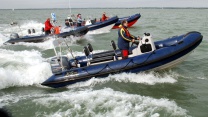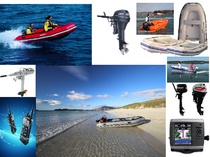XS Ribs UK Manufacturers of Boats that Work !
Click on the Individual boat, in the navigation to the left, that you want to look at.
This PDF discusses the various different types of craft both in style and size, if you are new to Ribs it is worth looking at.
CHOOSING A BOAT
We are often asked "How do I choose the right boat for me"
Well that is not easy to answer but the points you need to consider are easy to detail.
HULL LENGTH:
This determines the ride in the sea, as long as you have a "matched motor" to the hull length ie not under powered or too heavy for the boat model the HULL LENGTH plays more part in the ride of the craft than any other single factor.
It is a simple fact that a 5 m boat rides better than a 4.6 and a 8.5 rides better than a 7.5 m. This does not mean that there is any thing wrong with a 4.6 or 7.5 it is just a case of picking a model that will meet your expectations.
When compairing craft CHECK HULL LENGTH not overall length, it is the HULL not the tubes that gives the ride and many other makes have a big tube over hang at the rear of the craft and therefore do not give as good a ride as an XS of the same overall length. Hull length is equal to internal length for most craft.
HULL VOLUME:
We have all been in boats where the ride is great with 1 person but add a few more and it slams. What is happening here is that the total weight in the craft has EXCEEDED the buoyancy in the hull, and if a Rib, when the hull cuts down in to the water the buoyancy is "overwhelmed" and the craft slams when the water hits the tubes. Here a deep V Hull, wider craft, gives more buoyancy in the hull and will keep a softer ride as payload increases. Many other makes have narrower hulls and will not have the ride an XS does for the same payload but will feel fine when "empty" Again check the internal beam that reflects the width of the hull NOT just the overall beam.
WEIGHT DISTRIBUTION:
In craft like an XS you can CHOOSE where the console and seating go. In many other craft you can not. In the rough waters of northern Europe weight forward in the craft gets the bow down and gives a better ride. Weight at the back of the craft can make a boat VERY hard to drive in the rough. [Dangerous]
Look at the craft and think about where the balance is in the craft and where and how you are going to use it, this may mean if the seating layout pushes weight "back" in the boat you need to look at "lightweight engines" or accept limitations to sea keeping.
SEATING:
You need to think about how many you are going to carry and if they need to be seated IN the boat rather than on the tubes. Be careful you do not end up with an exspensive floating seating unit and no room to do anything else, like stand up !
If you need to seat 6 taking in to account room in the boat, balance, and where you need to go whilst it CAN be achieved in a 5 m boat, really closer to 6 m may make more sense, just because it is "possible" does not make it the "optimum" craft.
HULL PROFILE:
If you need a soft ride in the rough DO NOT BUY a medium or shallow V hull craft BUT a deep V hull uses MORE HP to do the SAME as a shallower V hull craft.
If we look at the XS 540 - 545 - 550 on paper they sound like similar craft. In reality to achieve what a XS 540 with a F 60 does you will you need a 70 hp on the XS 545 and an 80 hp on the XS 550. OBVIOUSLY this has a cost implication but the XS 550 with a F 80 will give a softer ride in the rough with say 4 people on compared to the shallower, narrower hull profile of the XS 540.
ENGINE CHOICE:
You need to match the motor to what you want the boat to do. Remember that a motor running at 4000 RPM compared to the SAME motor running flat out (5500 RPM) will use HALF the petrol of the flat out one and last TWICE as long in terms of lifetime running. A motor that is too heavy for the boat will fudamentally alter the overall handling and performance of the craft and can make some boats dangerous in the rough.
In summary work out what you think you want to do, and then add a safety margin, if you think you just want to "go round the corner" when you get your new boat you will quickly realise that you "can and want to go further" You do not want to quickly outgrow this new boat so build in some room to expand your horizons LITERALLY !
HOPE THAT WAS OF SOME HELP !






